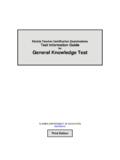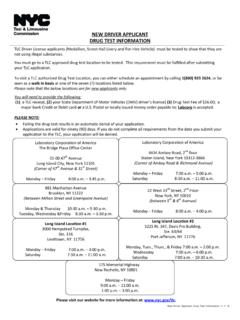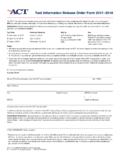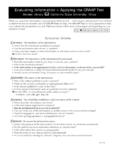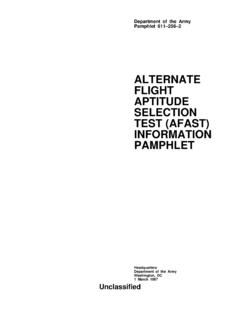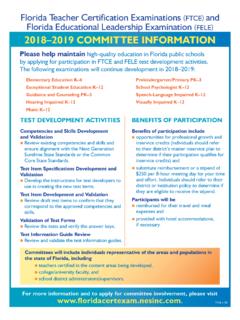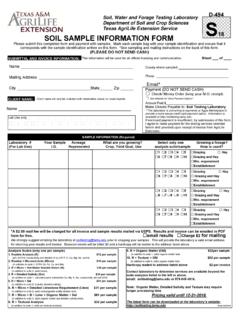Transcription of NRCME Certification Test Information and Sample …
1 NRCME Certification Test Information and Sample Test Questions The Certification Test FMCSA modeled the development of the Certification test on recognized processes and procedures established by the National Commission for Certifying Agencies (NCCA), a national accreditation body for a variety of Certification programs and organizations that assess professional competency. The NCCA uses a peer review process to establish accreditation standards, evaluate compliance with the standards, Certification . FMCSA used these standards for Certification test development so medical examiners, the drivers they examine, the motor carriers that employ the drivers and the public would have confidence in the qualifications of FMCSA certified medical examiners. Test Construction FMCSA performed an extensive role delineation study to identify the critical knowledge, skills, and abilities needed to perform CMV driver physical examinations in accordance with current FMCSA regulations and advisory criteria.
2 A variety of methods were used to complete the study, including an literature review, direct observations of CMV driver physical examinations, a national survey of medical examiners, and medical examiner expert Working Integrated Product Team (WIPT) meetings. The study results provided a blueprint for the FMCSA Medical Examiner Certification Test and the development of core curriculum specifications for the initial medical examiner training that will be provided by private-sector training organizations. Test Content Test Specifications The final test specifications shown in Table 1 reflect the number of items and cognitive level of questions for each content area on the Certification test. These specifications were developed combining medical examiner survey results and consensus of WIPT members. This blend of survey results and consensus among medical examiners is superior to using either element alone.
3 Table 1: Core Content Areas Sample test questions answers follow Using cardiovascular medical guidance, for each driver, is the driver medically qualified or medically disqualified? 1. Driver with percutaneous coronary intervention (PCI) nine months ago; he or she has not followed up with cardiologist and has not had exercise tolerance test (ETT) since procedure. 2. Coronary artery bypass graft (CABG) surgery four months ago; echo at three months showed LVEF 55%; driver was cleared by cardiologist and has no chest pain. 3. Driver with CHF having dyspnea at rest. 4. Driver has recently had increasing angina which lasted 20 minutes after tarping a load; he or she is unresponsive to nitroglycerin. 5. What are the differences between the medical standards and the medical guidelines? 6. A driver presents for examination with a history (last month) of a pneumothorax.
4 The records provided by the driver indicate that the pneumothorax reduced the driver s forced vital capacity (FVC) to 58% of predicted forced vital capacity. Can this driver be certified? If not, when can the driver be certified? Which of the following conditions would require the driver to complete qualifying procedures under 49 CFR 7. Missing fourth and fifth fingers of right hand; has strong hand grasp. 8. Missing right foot since age two; uses prosthesis and runs marathons. 9. Status post-crush injury to left arm; has atrophy and weakness in ulnar distribution. 10. Suffering from carpal tunnel syndrome; has weak hand grasp. 11. When evaluating a driver with a psychological disorder that might interfere with safe operation of a CMV, what behaviors should an examiner look for? 12. What is the purpose of the Interstate CMV driver physical examination? 13.
5 What is the mission of FMCSA? 14. Who and what does FMCSA regulate? 15. Give some examples of CMV driver stress factors. 16. What are possible outcomes of the CMV driver physical exam? What is ME certificate expiration date for following drivers? 17. Joe came in for exam on 2/1/2011 met standards in 49 CFR ; qualifies for 2 year certificate. 18. Pat came in for exam on 2/1/2011 met standards but periodic monitoring required due to hypertension driver qualified 1 year. 19. Sandy came in for exam on 2/1/2011 Disqualified due to not having results of post-CABG stress test for review. 2/15/2011 Return to ME s office with test results (attached) driver qualified 1 year. 20. Stan came in for exam on 2/1/2011 Disqualified due to diagnosis of benign positional vertigo on 3/10/2011. 4/3/2011 Returns to ME s office for Certification Exam. (Note: asymptomatic since 3/8/2011 but periodic.)
6 Driver qualified for 2 years. 21. Who can perform the vision portion of the interstate CMV driver physical examination? 22. To pass the interstate CMV driver vision exam, a visual acuity of _____ corrected or uncorrected is required. 23. What eye conditions must the medical examiner ask the driver about and if indicated request specialist evaluation? 24. Does this driver meet hearing standards for interstate CMV driver Certification ? Whisper test results | Rt. Ear: 4 Feet | Lt. Ear: 4 Feet | 25. Does this driver meet hearing standards for interstate CMV driver Certification ? Audiometric test results [Hearing loss in decibels (dB) 500 Hz, 1,000 Hz, 2,000 Hz] Rt. Ear: 30, 45, 40 | Lt. Ear: 45, 45, 35 | 26. Can an interstate CMV driver who has had an acute myocardial infarction (AMI) be qualified to drive? 27. The driver provides the medical examiner with a copy of records, including a cardiologist s report indicating a diagnosis of congestive heart failure and that the driver s ejection fraction is 38%.
7 Can the driver be certified? 28. A driver has an abdominal aortic aneurysm. The medical examiner obtains a copy of an abdominal sonogram indicating that the aneurysm is cm in diameter. According to current CVD recommendations, should the medical examiner certify this individual? 29. Before the examination begins, the driver gives the examiner a letter from his cardiovascular surgeon, indicating that he had surgical repair of a 9 cm abdominal aortic aneurysm four months previously, and the driver is now cleared to resume all activities. According to current CVD recommendations, can the examiner certify this driver? 30. Using current FMCSA guidelines, what is the proper determination for an interstate CMV driver, with a diagnosis of hypertension, who presents with a confirmed blood pressure of 182/112? 31. Using current FMCSA guidelines, what is the maximum period of Certification for a driver disqualified for Stage 3 hypertension, but who has, at the Certification examination, a blood pressure less than 140/90?
8 32. A CMV driver with a diagnosis of hypertension presents with a BLOOD PRESSURE of 182/112. This is Stage ____. 33. What is the BLOOD PRESSURE range for Stage 1 hypertension? 34. What conditions must a driver with acute or chronic cor pulmonale meet to be certified to operate an interstate CMV? 35. A driver states that she has exercise- induced asthma well controlled by using an albuterol (Proventil, Ventolin) inhaler before she does any aerobic activity. Her pulmonary function (forced expiratory volume in the first second of expiration (FEV1)) must be greater than _____ % of predicted FEV1 to qualify. 36. A driver takes diphenhydramine (Benadryl), 25 mg, two or three times per day, to treat nasal congestion. Discuss what, if any, concerns this causes, and what a medical examiner might do in this example. 37. The examiner notices that the driver has marked that he has asthma and lists an albuterol [Proventil, Ventolin] inhaler among his medications.
9 On questioning, the driver admits to using it several times a day, especially during the spring and fall; he admits that he has not seen his primary care physician in several years but is still getting frequent refills on his inhaler. The driver also admits that he has been hospitalized twice in the last six months for his asthma, ending up on a ventilator on the last visit. Should the medical examiner certify the driver, if so, for how long? 38. A driver presents for examination with a history (last month) of a pneumothorax. The records provided by the driver indicate that the pneumothorax reduced the driver s forced vital capacity (FVC) to 58% of predicted forced vital capacity. Can this driver be certified? If not, when can the driver be certified? 39. A driver presents for examination with a history (three months ago) of a pneumothorax. The records provided by the driver indicate that this is the second spontaneous pneumothorax on the same side.
10 The driver s forced vital capacity (FVC) to 68% of predicted forced vital capacity is with no surgical intervention. Can this driver be certified? If not, when can the driver be certified? 40. According to regulation, for what neurological condition is medically disqualifying for the interstate CMV driver Certification ? 41. According to medical guidance, for which of the following diagnosed neurological conditions is the driver considered medically unqualified for driving? A. Febrile seizure. B. Dementia (severe) C. Dementia (metabolic) D. Transient ischemic attacks (within one year) E. Transient ischemic attacks (greater than one year ago) 42. A driver is taking levodopa/carbidopa (Sinemet) Levodopa/carbidopa may cause the driver to be disqualified because it is used for the treatment of what? 43. Ms. Miller s left arm has mild symptoms and is weaker than the right. At what level of left arm strength would the medical examiner certify Ms.
